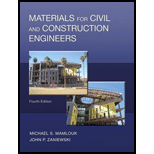
Pearson eText for Materials for Civil and Construction Engineers -- Instant Access (Pearson+)
4th Edition
ISBN: 9780137505586
Author: Michael Mamlouk, John Zaniewski
Publisher: PEARSON+
expand_more
expand_more
format_list_bulleted
Concept explainers
Question
Chapter 9, Problem 9.39QP
To determine
Discuss how the indirect tensile resistant modulus is determined in the lab.
Expert Solution & Answer
Want to see the full answer?
Check out a sample textbook solution
Students have asked these similar questions
Define the Thomas (1968) Elastic Modulus from CPT ?
What are the underlying assumptions when calculating for the upper and lower bounds of the elastic modulus.
PROBLEM 3A tensile test is performed on a brass specimen 10mm in diameter using a gage length of 50mm. When the tensile load P reaches a value of 20kN, the distance between the gage marks has increased by 0.122 mm. What is the modulus of elasticity?
Note: Please show complete solution with FBD
Chapter 9 Solutions
Pearson eText for Materials for Civil and Construction Engineers -- Instant Access (Pearson+)
Ch. 9 - Prob. 9.1QPCh. 9 - Prob. 9.2QPCh. 9 - Prob. 9.3QPCh. 9 - Prob. 9.4QPCh. 9 - Prob. 9.5QPCh. 9 - Prob. 9.6QPCh. 9 - Prob. 9.7QPCh. 9 - What are the engineering applications of each of...Ch. 9 - Prob. 9.9QPCh. 9 - Prob. 9.10QP
Ch. 9 - Prob. 9.11QPCh. 9 - Prob. 9.12QPCh. 9 - Prob. 9.13QPCh. 9 - Prob. 9.14QPCh. 9 - Prob. 9.15QPCh. 9 - Prob. 9.16QPCh. 9 - Prob. 9.17QPCh. 9 - Prob. 9.18QPCh. 9 - What are the objectives of the asphalt concrete...Ch. 9 - Prob. 9.20QPCh. 9 - Prob. 9.21QPCh. 9 - Prob. 9.22QPCh. 9 - Prob. 9.23QPCh. 9 - Prob. 9.24QPCh. 9 - Prob. 9.25QPCh. 9 - An asphalt concrete mixture includes 94% aggregate...Ch. 9 - Prob. 9.27QPCh. 9 - Prob. 9.28QPCh. 9 - Prob. 9.29QPCh. 9 - Prob. 9.30QPCh. 9 - Based on the data shown in Table P9.31, select the...Ch. 9 - Based on the data in Table P9.32, determine the...Ch. 9 - Given the data in Table P9.33, select the blend...Ch. 9 - The Marshall method of mix design has been widely...Ch. 9 - Prob. 9.35QPCh. 9 - Prob. 9.36QPCh. 9 - Prob. 9.37QPCh. 9 - Prob. 9.38QPCh. 9 - Prob. 9.39QPCh. 9 - Prob. 9.40QPCh. 9 - Prob. 9.41QPCh. 9 - Prob. 9.42QPCh. 9 - Prob. 9.43QPCh. 9 - What is the purpose of adding fly ash to asphalt...Ch. 9 - Prob. 9.45QPCh. 9 - Prob. 9.47QPCh. 9 - Prob. 9.48QP
Knowledge Booster
Learn more about
Need a deep-dive on the concept behind this application? Look no further. Learn more about this topic, civil-engineering and related others by exploring similar questions and additional content below.Similar questions
- Pls answer thanksarrow_forwardPlease present FBD/s A tensile test is performed on a brass specimen 10mm in diameter using a gage lenght of 50mm. When the tensile load P reaches a valule of 20kN, the distance between the gage marks has increased by 0.122mm. What is the modulus of elasticitiy of the brass?arrow_forwardShow complete solution with FBD.arrow_forward
- PROBLEM 3 A tensile test is performed on a brass specimen 10mm in diameter using a gage length of 50mm. When the tensile loadP reaches a value of 20KN, the distance between the gage marks has increased by 0.122 mm. What is the Poisson's ratio if the diameter decreases by 0.00830 mm.?arrow_forwardneed helparrow_forwarda. Assuming the computer and the printer are turned on, what will be the next step to do when trying to perform a test?b. What part of the UTM will you use to remove the tensile test specimen from the grips?c. In what direction does the lower crosshead move during a tensile test?d. In what direction does the lower crosshead move during a compression test?e. In what direction does the lower crosshead move during a bending test?arrow_forward
- A 40 mm diameter steel bar is subjected to a tension test. Under a tension load of 276.46 kN, it was observed that the original gage length of 50 mm increased in length by 0.055 mm, & the diameter decreased by 0.0105 mm. Find the modulus of elasticity (MPa) (in whole number)arrow_forwardA beam made of Al 2014-T6 aluminum alloy is loaded by an oblique bending moment of M = 5 kN.m as shown in the figure. a) Calculate the tensile and the compressive stress values. b) Define the location and the orientation of the Neutral Axis and draw it on the figure. Note: The cross-sectional dimensions are the same with the one in the 3rd question of the final exam. Therefore, you do not need to find the location of the centroid and the value of the moment of inertia about the z axis, I, You can directly use the values in the 3rd question. 5 kN.m 90 mm 30 10 mm 90 mm ! 10 mm Window Windows'uarrow_forwardThe following terms apply to LRFD (limit state design) and ASD. Which of the following is a limit state design concept?arrow_forward
- Q2/Show the mechanical properties changes during tensile test of a metal specimen. Write the mathematical relationships. 443Xarrow_forwardCan I get a walkthrough for this problem?arrow_forwardA tension test was conducted for a cylindrical specimen of stain-less steel having an initial diameter (D) of 15.35 mm. Calculate the percentage reduction in area if the final diameter of the specimen (d) is 10.25 mm. Select one: O a. 57.41% b. 56.41% O c. 55.41% d. 58.41% Clear my choicearrow_forward
arrow_back_ios
SEE MORE QUESTIONS
arrow_forward_ios
Recommended textbooks for you
 Steel Design (Activate Learning with these NEW ti...Civil EngineeringISBN:9781337094740Author:Segui, William T.Publisher:Cengage Learning
Steel Design (Activate Learning with these NEW ti...Civil EngineeringISBN:9781337094740Author:Segui, William T.Publisher:Cengage Learning

Steel Design (Activate Learning with these NEW ti...
Civil Engineering
ISBN:9781337094740
Author:Segui, William T.
Publisher:Cengage Learning